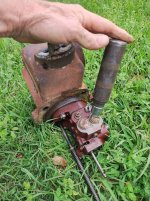Hello There.
I got this David Brown/CASE 855 from local auction (for $1250+125 auction premium+ 120 hiring trailer), unkown model year. I don't know if it's a good deal or not.
It's my first real tractor, in hope to do some yard work with it, moving gravel dirt and clear dense blackberry high grass with PTO attachment.
I know pretty much about car repair (my hobby) and with lot of car tools, and repaired riding lawn mower before. But no experience on real tractor. After initial assessment, I think the biggest enemies to deal with are: 1, old rust, 2, heavy part to be removed such as big wheel, final reduction, 3, antique parts. I am surprised that the tractor parts (no matter new or old models) are so expensive compared to ebay auto parts. As early ground work, I have found the operator manual, service manual, bulletins, part number manual.
I plan to fix the issues I found and gonna find, to bring it back to work, with mad max/fallout style cheap redneck methods as much as possible. Sounds good? I hope to borrow some priceless knolewledge from you guys on such antique machine, please give me some guidance and advise. Any idea would be great.
Issues, todo list (I will update):
1. Hydraulic
the loader moves but slowly. Had not figured out how to make lift hitch moving because I just managed to get it back home for 2 days.
I found the hydro fluid is milky color on dipstick. The shifter boots are teared pretty bad. It's said water can go into from there. The hydraulic fluid and filter needs to be changed for sure.
For shifter boots, I can simply put another layer of used rubber glove on the outside, to make it waterproof. A simple fix.
For such tear on the boots, how bad the hydro fliud could be? Could it be the culprit of slow moving? It looks like has been sitting outdoor without much use for pretty long time.
2. Brake
Both sides dry brake are stuck. The camshaft needs heavy hammer to move little by little between open and close positions. I think the camshaft is stuck by old rust. Proved my guess that not used for long time.
3. Throttle lever friction disc
The lever doesn't stay. The big holding nut is rusted on the lever shaft.
4. Lubricate every moving link, make grease fitting when needed. The pedals and levers feels stiff due to rusty links. The homemade style front end loader's links are rusty worse. I didn't find grease fitting on some critical links. Need to drill and put on fittings.
5. Instrument panel, wiring
Because of possible wrong wiring, the alternator area got on fire due to short when I putting on the new battery. The wire from alternator to starter solenoid shorted.
All warning lights are gone (plan to fix). Light related switchs are gone (leave it as is).
View attachment 62519View attachment 62520View attachment 62521View attachment 62522View attachment 62523View attachment 62524View attachment 62525View attachment 62526View attachment 62527View attachment 62528
drive.google.com
sites.google.com


